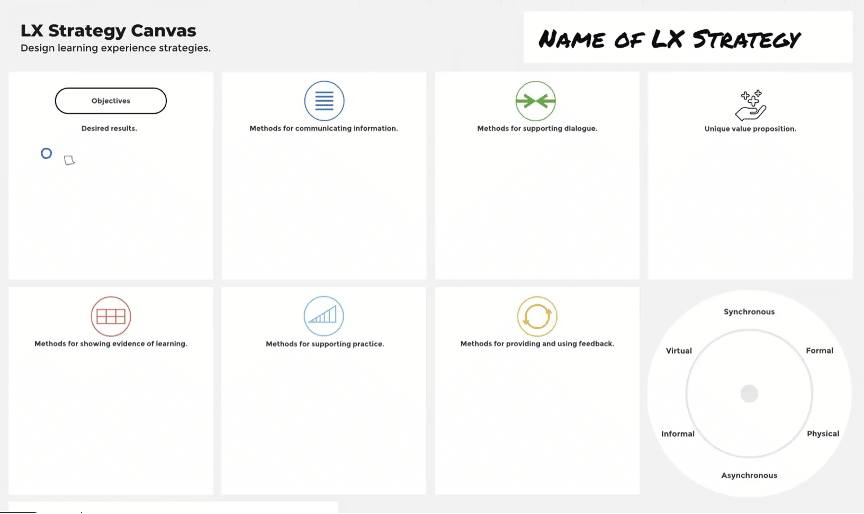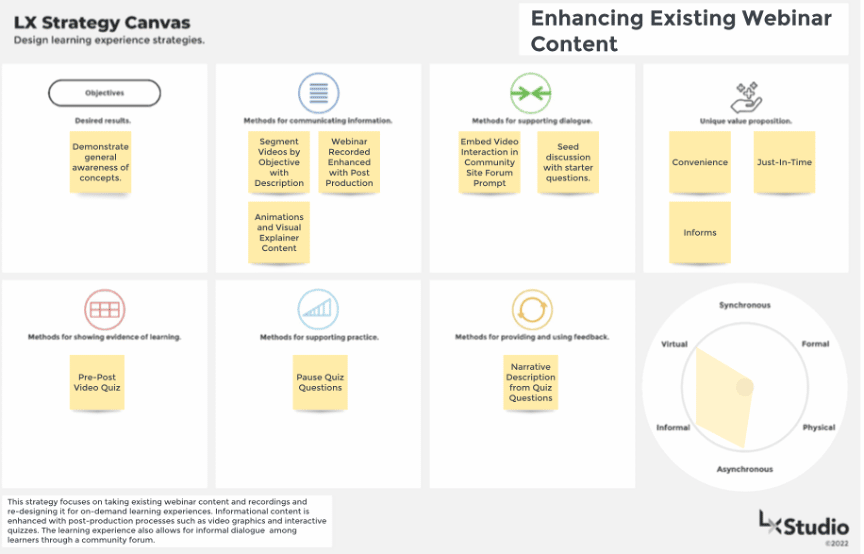Dr. Bucky Dodd is passionate about helping people learn and designing world-class learning experiences. He’s assistant vice president for education, strategy, and innovation with LX Studio at the University of Central Oklahoma, and he created Learning Environment Modeling®, a visual collaboration system for the design and evaluation of learning experiences. He’s also published a playbook called “Supercharge Your Webinar Strategy,” which explores five specific strategies for better Webinars.
In this episode of the Leading Learning Podcast, co-host Jeff Cobb talks to return guest Bucky about learning environments, learning experience design, learning campaigns, and a strategic approach to creating better Webinar experiences.
To tune in, listen below. To make sure you catch all future episodes, be sure to subscribe via RSS, Apple Podcasts, Spotify, Stitcher Radio, iHeartRadio, PodBean, or any podcatcher service you may use (e.g., Overcast). And, if you like the podcast, be sure to give it a tweet.
Listen to the Show
Access the Transcript
Download a PDF transcript of this episode’s audio.
Read the Show Notes
[00:00] – Intro
LX Studio
[01:35] – Tell us about your role at the University of Central Oklahoma and what you’re doing with LX Studio.
LX Studio is part of the University of Central Oklahoma and it serves both the university and external partners. At LX Studio, they work with university faculty, staff, and administrators.
They also work with partners from across industries who are trying to engage people in learning. LX Studio is unique because they serve a consulting function and also get to be a partner through the process of change and transformation with both internal and external clients.
Learning Experience (LX) Design and Learning Environment
[02:52] – Your work is driven by a focus on learning experience design as well as by the concept of learning environment (both discussed the last time you were on the podcast). What do those concepts mean to you and how has your thinking about them evolved since the massive shift to online learning during the pandemic?
As an example of learning environment, think about a formal education setting where we walk into a classroom and see desks set up in rows. That environment cues us as to what should happen in that space. Now, take that example, and compare it to what we might see in a coffee shop. The coffee shop environment cues us to think about conversation and collaboration. Learning happens differently in those two environments.
Bucky’s work has been shaped by the effect learning environments (the spaces and places where people learn) have on the learning experience. It can be empowering for learning designers and leaders to realize they have a lot of agency in designing learning environments, whether those environments be our workplaces, classrooms, or informal digital spaces like social media. The environments have a profound impact on how learning experiences happen and how people engage.
Learning historically occurred in physical spaces in a formal context. Then, with COVID, almost overnight we had to shift the learning environment online. Many organizations also began looking more intentionally at the informal side of learning. We saw many associations and higher education institutions thinking about how to engage their learners, not just in a formal sense, but socially. They realized they weren’t there only to deliver content, but also to create rich, vibrant experiences where learning can happen and can thrive.
[06:04] – What are you seeing organizations wrestle with the most when it comes to thinking about learning environments and designing learning experiences?
Bucky thinks now is a very exciting time as we’re coming off some tremendous innovation. Organizations pivoted to reach audiences in new ways. In the process, those organizations created a lot of what Steven Johnson calls “spare parts.” (Johnson is one of Bucky’s favorite authors on innovation). Organizations created Webinars, guide sheets, and much more. Now there’s an opportunity to think about how best to use those assets in intentional ways.
And so I think we are going to see a greater focus on strategy. I think we’re going to see a greater focus on the intentionality of design with the challenge not being necessarily how do we produce this media or how do we create this video. We figured that out, right? We sort of innovated through that process, but it’s how do we do it in effective ways?
Bucky Dodd
There’s a new focus on quality and efficacy. Bucky is seeing lots of iteration, which reminds us that we’re never done learning, even ourselves. We as learning leaders and learning providers have to continue improving and we can bring other people along the way with us.
Audiences have given us some grace. Learners recognize that, just like them, learning businesses had to step into the unknown. Not everything goes perfectly, but we can learn and improve based on the feedback from an engaging community of learners.
Partner with Tagoras
[09:17] – At Tagoras, we’re experts in the global business of lifelong learning, and we use our expertise to help clients better understand their markets, connect with new customers, make the right investment decisions, and grow their learning businesses.
We achieve these goals through expert market assessment, strategy formulation, and platform selection services. If you are looking for a partner to help your learning business achieve greater reach, revenue, and impact, learn more at tagoras.com/services.
A Holistic Approach to Learning Offerings
[09:51] – Are you seeing organizations think about their learning portfolio more holistically and explore how different types of content can complement and add value to each other?
Bucky believes people are recognizing the assets they have across their organization. They had to come together and work together during the pandemic, and he thinks that collaboration and innovation will continue. He’s excited about the concept of learning campaigns. We have historically focused too much on what happens in a learning management system. Learning campaigns allow us to connect technologies and digital strategies to meet people where they are.
We need to reach people in convenient, timely, and meaningful ways. That means drawing on resources from across an organization. It means understanding where the learner is and how to design in ways that add value to them.
We tend a lot of times in education to think about learning as an event, which is really short-sighted. And I think thinking about campaigns or experiences or broad strategies that bring people together is a much more well-rounded way of thinking about that than just what happens in a workshop or a conference or something like that.
Bucky Dodd
Current State of Webinars
[12:35] – How would you describe the state of Webinars in the current emerging-from-the-pandemic world?
At the start of the pandemic Webinars were an accessible, quick, and affordable way to reach audiences. That meant that most of what we saw in Webinars was a transfer of what would happen in a classroom. That served an important purpose. But other opportunities have emerged where we can potentially leverage technology in more transformative ways and look at how to get the best value that we can from a Webinar experience.
Leveraging technology will continue to advance, but we shouldn’t let technology drive the threshold of our innovation. Sometimes the tools that are designed for one purpose can be perfect for serving another purpose. We’re just at the beginning of a new wave of innovation that will impact many things, including Webinars.
Strategy Canvas for a Webinar
[15:53] – Can you describe the strategy canvas that you use for Webinars and how that works?
The strategy canvas is important because it makes makes what’s often invisible, visible. Often when we design learning experiences, much of the process happens in our minds or when we talk to one another. But we hit a barrier when we’re trying to work on a problem together.
The canvas is a visual tool that helps multiple people come together to problem-solve and think strategically. It starts with the desired results, working from the end. This backward design encourages us to think about the evidence of learning and what we want the learner to be able to do. Where we want to go and the evidence to prove we’ve arrived are important dimensions for ensuring alignment.

Some other elements in the strategy canvas are based on Learning Environment Modeling language, a visual framework for designing learning experiences.
The strategy canvas prompts questions such as the following:
- How do we promote practice in the learning experience?
- How do we intentionally design feedback moments in the learning experience?
- How do we have a dialogue?
- What information is delivered?
The strategy canvas emphasizes the value proposition. Bucky has been working lately on designing value propositions for learning experiences that matter. This is an area that we historically have not spent as much time on as we probably should. The canvas also includes a visual compass that helps articulate the blend of the learning environment, whether it’s digital, in-person, formal, informal, synchronous, or asynchronous.
The canvas provides a one-page visual, and that allows us to collaborate and think strategically together about the design of learning experiences. Jeff notes that, at Leading Learning, we refer to tools like the strategy canvas as social learning objects.
Webinar Playbook
[20:42] – You’ve developed five specific strategies for better Webinars and collected these in a playbook. Can you give a few highlights of those strategies?
LX Studio created the “Supercharge Your Webinar Strategy” playbook (which is freely available) for organizations that have some experience with Webinars but want to improve and take their Webinars to the next level.
They started with a “how to enhance what you’re currently doing with Webinars” approach. Below is an example showing how this is done using the LX Strategy Canvas.

LX Studio also looks at more sophisticated strategies in the playbook—for example, leveraging recorded content into effective asynchronous learning experiences. The playbook also addresses about learning campaigns and blended approaches.
The playbook is a way to help learning businesses that have done some Webinars to go down an innovation pathway at their own pace and at their own comfort level, exploring new ideas. Bucky encourages you not use the playbook as set recipes. Get creative.
Approach to Lifelong Learning
[23:24] – For your own lifelong learning, how do you identify and shape the learning experiences and the learning environments that are going to be most valuable to you? Has your approach changed as a result of what’s happened since the pandemic?
To be good designers of learning experiences for other people, we have to first be good designers of learning experiences for ourselves. We need to understand how we design our own learning environments to think strategically and stretch ourselves.
Bucky recently read The Upside of Uncertainty, which aims to reframe our thinking about uncertainty. When we even hear the word “uncertainty,” we get anxious. Uncertainty is perceived as a bad thing. But the book helped Bucky reframe his thinking.
Uncertainty is really an opportunity, right? If we’re ever going to create something new, or we’re ever going to grow our organization, or we’re ever going to invest in new opportunities, at some point we’re going to have to traverse uncertainty. It is a given.
Bucky Dodd
We can apply thinking to the design of learning experiences. Our learners encountering new skills are information are on the ledge of uncertainty. Our role as educators, leaders, and designers is to help them traverse that uncertainty.
[27:36] – Wrap-up
Dr. Bucky Dodd is assistant vice president for education, strategy, and innovation with LX Studio at the University of Central Oklahoma. You can connect with Bucky on LinkedIn.
To make sure you don’t miss new episodes, we encourage you to subscribe via RSS, Apple Podcasts, Spotify, Stitcher Radio, iHeartRadio, PodBean, or any podcatcher service you may use (e.g., Overcast). Subscription numbers give us some data on the impact of the podcast.
We’d also be grateful if you would take a minute to rate us on Apple Podcasts at https://www.leadinglearning.com/apple or wherever you listen. We personally appreciate reviews and ratings, and they help us show up when people search for content on leading a learning business.
Finally, consider following us and sharing the good word about Leading Learning. You can find us on Twitter, Facebook, and LinkedIn.
Episodes on Related Topics:



 Tool Talk: Learning Culture and Learning Ecosystem Snapshots
Tool Talk: Learning Culture and Learning Ecosystem Snapshots
Leave a Reply